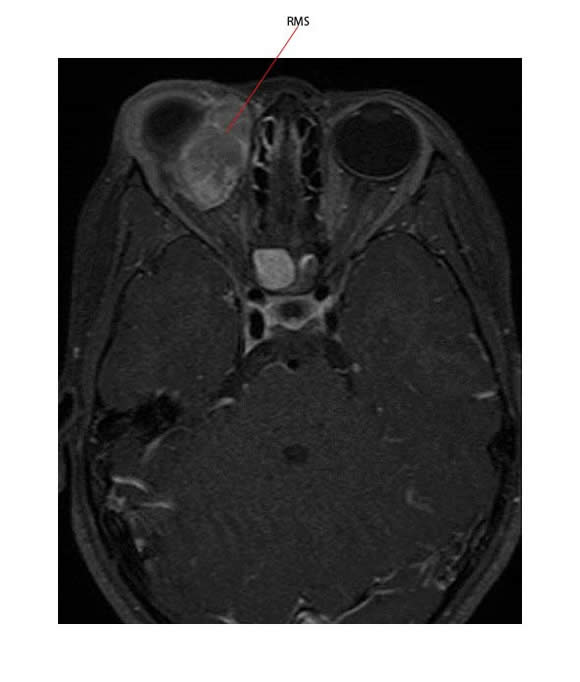This accounts for about 10% of all rhabdomyosarcomas (RMS).
Exenteration was the standard treatment in the 1960s. There were few survivors and local control was rarely achieved. Then it was observed that radiation therapy (RT) was effective.
Tumors may produce proptosis and ophthalmoplegia.
The MR below shows an orbital RMS:

Disease tends to be diagnosed early at this site and orbital RMS has a good prognosis. In the setting of the Children's Oncology Group, this tumor site is treated on a protocol for low risk category RMS (a 5-year relapse-free survival of 85% on previous IRS studies).
Regional lymph node involvement is very rare (scanty orbital lymphatics).
Histology is usually embryonal and these tumors rarely metastasize.
Most patients have Stage 1, but clinical group III disease (gross residual disease which is not amenable to surgical resection).
The RT treatment technique:
- Usually a wedged pair is used (look carefully at exit dose in relation to opposite eye).
- The entire orbit does not need to be irradiated; only the tumor volume with margins (PTV).
- GTV = pre-treatment visible and/or palpable disease (on examination,operative surgical findings, CT scan, or MR scan).
- CTV = GTV + 1.0 cm
- The only specified modification for orbit primaries is that the CTV does not extend outside of the bony orbit (providing there is no bone erosion of the orbit).
- PTV = CTV plus a margin to account for daily setup variation and physiologic motion of the CTV. Usually this margin will be 5 mm.
- The dose for Clinical Group III orbit tumors is 45 Gy in 180 cGy fractions.
- Every attempt should be made to shield the lens, cornea, lachrymal gland and optic chiasm.
- Recommended organ dose limits:
- Lachrymal gland 4140 cGy
- Optic nerve and chiasm 4680 cGy
- Late effects can be significant with:
- Cataracts
- Facial hypoplasia in at least 60% of patients
- Stenosis of the lachrymal duct
- Retinal damage (reduced vision in affected eye in about 70%).
In the past when the treatment dose was higher, there was a risk of RT induced glaucoma causing a painful, blind eye which would require enucleation.
Link:


